自动控制系统英文原理
- 格式:doc
- 大小:37.00 KB
- 文档页数:6
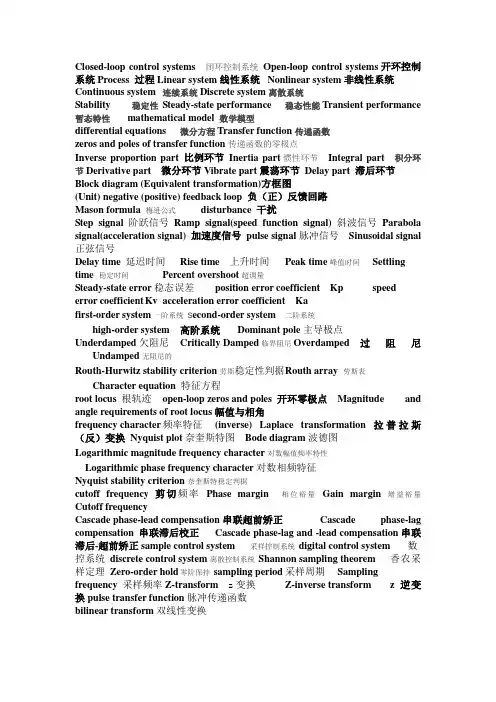
Closed-loop control systems 闭环控制系统Open-loop control systems开环控制系统Process 过程Linear system线性系统Nonlinear system非线性系统Continuous system 连续系统Discrete system离散系统Stability 稳定性Steady-state performance 稳态性能Transient performance 暂态特性mathematical model 数学模型differential equations 微分方程Transfer function传递函数zeros and poles of transfer function传递函数的零极点Inverse proportion part 比例环节Inertia part惯性环节Integral part 积分环节Derivative part 微分环节Vibrate part震荡环节Delay part 滞后环节Block diagram (Equivalent transformation)方框图(Unit) negative (positive) feedback loop 负(正)反馈回路Mason formula 梅逊公式disturbance 干扰Step signal 阶跃信号Ramp signal(speed function signal) 斜波信号Parabola signal(acceleration signal) 加速度信号pulse signal脉冲信号Sinusoidal signal 正弦信号Delay time延迟时间Rise time 上升时间Peak time峰值时间Settling time 稳定时间Percent overshoot超调量Steady-state error稳态误差position error coefficient Kp speed error coefficient Kv acceleration error coefficient Kafirst-order system一阶系统S econd-order system 二阶系统high-order system 高阶系统Dominant pole主导极点Underdamped欠阻尼Critically Damped临界阻尼Overdamped 过阻尼Undamped无阻尼的Routh-Hurwitz stability criterion劳斯稳定性判据R outh array 劳斯表Character equation 特征方程root locus 根轨迹open-loop zeros and poles 开环零极点Magnitude and angle requirements of root locus幅值与相角frequency character 频率特征(inverse) Laplace transformation 拉普拉斯(反)变换Nyquist plot奈奎斯特图Bode diagram波德图Logarithmic magnitude frequency character对数幅值频率特性Logarithmic phase frequency character对数相频特征Nyquist stability criterion奈奎斯特稳定判据cutoff frequency 剪切频率Phase margin 相位裕量Gain margin 增益裕量Cutoff frequencyCascade phase-lead compensation串联超前矫正Cascade phase-lag compensation 串联滞后校正Cascade phase-lag and -lead compensation串联滞后-超前矫正sample control system 采样控制系统digital control system 数控系统discrete control system离散控制系统Shannon sampling theorem 香农采样定理Zero-order hold 零阶保持sampling period 采样周期Sampling frequency 采样频率Z-transform z变换Z-inverse transform z逆变换pulse transfer function脉冲传递函数bilinear transform双线性变换。
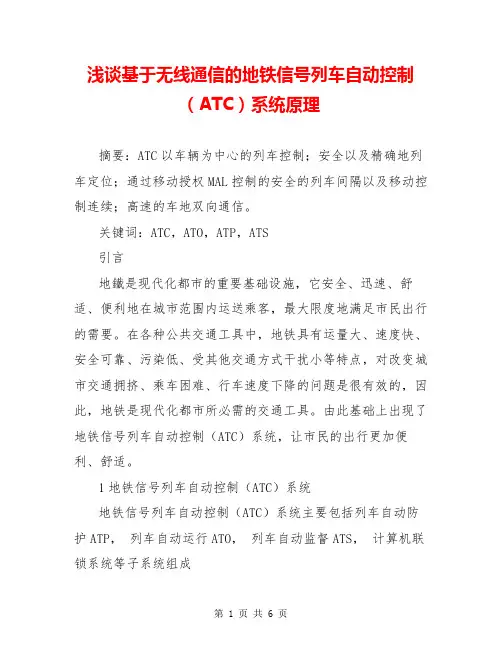
浅谈基于无线通信的地铁信号列车自动控制(ATC)系统原理摘要:ATC以车辆为中心的列车控制;安全以及精确地列车定位;通过移动授权MAL控制的安全的列车间隔以及移动控制连续;高速的车地双向通信。
关键词:ATC,ATO,ATP,ATS引言地鐵是现代化都市的重要基础设施,它安全、迅速、舒适、便利地在城市范围内运送乘客,最大限度地满足市民出行的需要。
在各种公共交通工具中,地铁具有运量大、速度快、安全可靠、污染低、受其他交通方式干扰小等特点,对改变城市交通拥挤、乘车困难、行车速度下降的问题是很有效的,因此,地铁是现代化都市所必需的交通工具。
由此基础上出现了地铁信号列车自动控制(ATC)系统,让市民的出行更加便利、舒适。
1地铁信号列车自动控制(ATC)系统地铁信号列车自动控制(ATC)系统主要包括列车自动防护ATP,列车自动运行ATO,列车自动监督ATS,计算机联锁系统等子系统组成2列车自动防护(ATP)的工作原理列车自动保护系统是确保列车运行速度不超过目标速度的安全控制系统。
它是列车自动控制(ATC)系统的子系统,也是确保列车安全运行,实现超速防护的关键设备。
该子系统通过设于轨旁的ATP地面设备,连续地向列车传送“目标速度”或“目标距离”等信息,以保持后续列车与先行列车之间的安全间隔距离,并监督列车车门和站台屏蔽门的开启和关闭的程序控制,确保它们的安全操作。
ATP子系统地面发送设备平时通过计轴、轨道电路、信标发送列车检测信息,以检查轨道区段的空闲和占用,当检测到列车占用该轨道区段时,将“目标速度”或“目标距离”等数据信息传送给列车。
车载ATP设备接收并解译“速度命令”等数据信息,结合列车实际速度、制动率、车轮磨损补偿等相关条件,实现超速防护控制,并与列车自动运行(ATO)子系统配合,实现列车速度的自动调整。
当列车到达定位停车点,由ATP子系统通过轨旁设备向列车传送列车车门开启和关闭信息,进行列车车门开、闭控制。
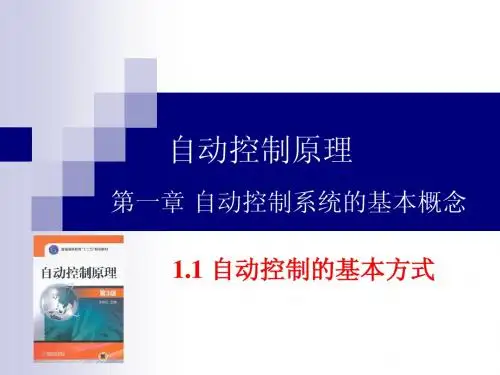
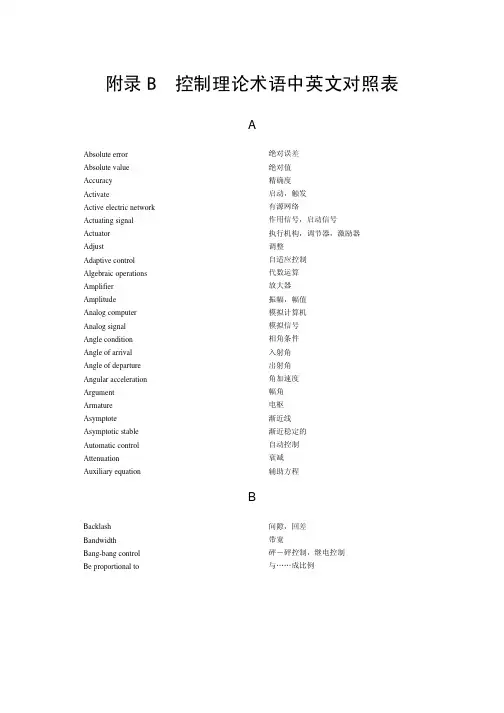
附录B 控制理论术语中英文对照表AAbsolute error 绝对误差Absolute value 绝对值Accuracy 精确度Activate 启动,触发Active electric network 有源网络Actuating signal 作用信号,启动信号Actuator 执行机构,调节器,激励器Adjust 调整Adaptive control 自适应控制Algebraic operations 代数运算Amplifier 放大器Amplitude 振幅,幅值Analog computer 模拟计算机Analog signal 模拟信号Angle condition 相角条件Angle of arrival 入射角Angle of departure 出射角Angular acceleration 角加速度Argument 幅角Armature 电枢Asymptote 渐近线Asymptotic stable 渐近稳定的Automatic control 自动控制Attenuation 衰减Auxiliary equation 辅助方程BBacklash 间隙,回差Bandwidth 带宽Bang-bang control 砰-砰控制,继电控制Be proportional to 与……成比例自动控制原理·326· ·326·Biocybernetics 生物控制论Block diangram 方框图,方块图,结构图 Bode plot 波特图 Branch分支,支路 Breakaway points 分离点 Bump 撞击,扰动 By-pass旁路CCACSD(Computer-Aided Control System Design) 控制系统计算机辅助设计 CACSE(Computer-Aided Control System Engineering) 控制系统计算机辅助工程 CAD(computer aided design) 计算机辅助设计 Cascade compensation 串联补偿校正 Cascade control 串级控制 Channel通道 Characteristic equation 特征方程 Characteristic gain locus 特征增益轨迹 Circuit电路Classical control theory 古典控制理论 Closed loop control system 闭环控制系统 Closed loop frequency response 闭环频率响应 Closed loop pole 闭环极点 Closed loop zero闭环零点 Combinational control system 复合控制系统 Comparator 比较器Comparing element 比较元件,比较环节 Compound control 复合控制 Compensation 补偿,校正 Complex plane 复平面 Conditional stability 条件隐定Configuration 结构,配置,方案,组态 Constant M loci 等M 圆 Continuous system 连续系统 Controlled variable 被控变量 Controlling machine 控制机 Control system 控制系统 Control valve 调节阀 Controllability 可控性,能控性附录B控制理论术语中英文对照表·327·Conveyor 传送器,传送带,传送装置Corner frequency 转折频率,交接频率Correcting unit 执行器Correction 校正Coupling 耦合Criterion 判据,准则Critical damping 临界阻尼Cut off rate 剪切率Cut off frequency 剪切频率Cybernetics 控制论DDamped natural frequency 有阻尼自然频率Dampe r 阻尼器Damping factor 阻尼系数Damping ratio 阻尼比Dead band 死区Dead time 纯延迟,延迟时间Decay 衰减,衰变Decomposition 分解Delay 滞后Delay element 滞后环节Denominator 分母Derivation action 微分作用Derivative control 微分控制Desired value 预期值,期望值Determinant 行列式Deviation 偏差Differencing junction 比较点Differential equations 微分方程Digital computer 数字计算机Discrete-data system 离散数据系统Disturbance 扰动,干扰Disturbance rejection property 抗干扰特性Dominate 主导Duality 对偶性Dynamic equation 动态方程Dynamic error 动态误差·327·自动控制原理·328··328·Dynamic process动态过程EEquilibrium state 平衡状态 Eigenvalue 特征值 Eigenvector 特征向量 Element 元件,环节 Error误差 Error coefficient 误差系数 Error signal 误差信号 Even symmetry 偶对称Exponential 指数,指数的,幂的 External description 外部描述 Extremum极值FFeasibility 可行性,可能性,现实性 Feedback 反馈 Feedback control 反馈控制 Feedback element 反馈环节 Feedback path 反馈通道 Feedforward前馈 Final controlling element 执行器 Final value 终值 First-order system 一阶系统 Focus焦点 Following device 随动装置 Forward path 前向通道 Fraction 分数 Frequency 频率 Frequency domain 频域 Frequency response频率响应 Frequency response characteristic 频率响应特性 Function 函数 Fuzzy control模糊控制附录B控制理论术语中英文对照表·329·GGain 增益Gain margin 增益裕度,幅值裕度Gear backlash 齿轮间隙General solution 通解Graphical method 图解法Guidance system 制导系统Gravitation area 引力域Gyro 陀螺HHarmonic 谐波,谐波量,谐振荡Harmonic response 谐波响应Holder 保持器Homogeneous equation 齐次方程Hurwitz determinant 赫尔维茨行列式Hydraulic system 液压系统Hysteresis error 回差Hysteresis loop 磁滞回环IIdealized system 理想化系统Identification 辨识Impulse response 脉冲响应Industrial robot 工业机器人Inertial 惯性的,惯量的,惰性的Inherent characteristic 固有特性Initial condition 初始条件Initial state 初始状态Initial value theorem 初值定理Inner loop 内环Input 输入Input node 输入节点Input signal 输入信号·329·自动控制原理·330· ·330·Integral action 积分作用 Integral control积分控制 IAE(integrated absolute error) 绝对误差积分 ISE(integrated square error) 平方误差积分 Internal description 内部描述 Intelligent instrument 智能仪表 Invariant 不变的,恒定的 Inverse matrix 逆矩阵 Inverse transformation 反变换 Inverse Laplace transforms 拉普拉斯反变换 Isocline method 等倾线法 Iterative algorithm迭代算法JJordan block 约旦块 Jordan canonical form约旦标准型KKalman criterion 卡尔曼准则 Kalman filter卡尔曼滤波LLag network 滞后网络 Lag compensation 滞后补偿 Laplace transforms 拉普拉斯变换 Large scale system 大系统 Lead network 超前网络 Least-mean-square 最小均方 Limit cycle 极限环 Linearization 线性化 Linearity 线性度 Linear equation 线性方程 Linear system 线性系统 Linear programming 线性规划 Load 负载附录B控制理论术语中英文对照表·331·Load-response curve 负荷响应曲线Locus 轨迹Logic diagram 逻辑图Log magnitude 对数幅值Low pass characteristic 低通特性MMagnitude condition 幅值条件Magnitude-versus-phase plot 幅相特性曲线Manipulated variable 操纵变量Mason rule 梅逊公式Mathematical model 数学模型Matrix 矩阵Maximum overshoot 最大超调量Measurable 可测量的Measured variable 被测变量Minimum phase system 最小相位系统Model decomposition 模型分解Modulus 模Moment of inertia 转动惯量Multinomial 多项式(的)Multivariable system 多变量系统NNatural frequency 自然频率Negative feedback 负反馈Nichols chart 尼柯尔斯图线Node 节点Noise 噪声Nonlinear control system 非线性控制系统Nonminimum phase system 非最小相位系统Nonsingular 非奇异的Norm 范数Numerator 分子Numerical control 数字控制,数控Nyquist criterion 奈奎斯特判据Nyquist contour 奈奎斯特轨线·331·自动控制原理·332··332·OObjective function 目标函数Observability 可观性,能观性Observer 观测器Odd symmetry 奇对称Off line 离线Offset 偏移,位移On line 在线Open loop 开环Optimal control 最优控制Optimization 最优化Origin 原点Oscillating loop 振荡回路Oscillation 振荡Oscillatory response 振荡响应Outer loop 外环Output 输出Output signal 输出信号Over damping 过阻尼Overshoot 超调量PParameter 参数Peak overshoot 超调峰值Peak time 峰值时间Performance index 性能指标Perturbance 扰动,摄动Phase lag 相位滞后Phase lead 相位超前Phase margin 相角裕度Phase modifier 相位调节器Phase plane 相平面Pickoff point 引出点PID(proportional plus integral plus derivative) controller PID (比例、积分、微分)控制器Piece-wise linearization 分段线性化Pneumatic controller 气动调节器,气动控制器附录B控制理论术语中英文对照表·333·Pole 极点Pole assignment 极点配置Polynomial 多项式Position error 位置误差Positive definiteness 正定性Pre-compensator 预补偿器Process control 过程控制Proportional action 比例作用Proportional band 比例带Proportional control 比例控制Prototype 原型,模型,样机Pulse 脉冲Pulse width 脉宽Pure delay 纯滞后QQuadratic 二次的Quadratic form 二次型Quality control 质量控制Quantizer 数字转换器RRamp input 斜坡输入Ramp response 斜坡响应Rate feedback 速度反馈Rate time 微分时间,预调时间Rational 有理(数)的,合理的Rational number 有理数Realization 实现Reference variable 参考变量Regulator 调节器Relay 继电器Relative stability 相对稳定性Reliability 可靠性Remote control 遥控Reproducibility 再现性Resilience 弹性,弹性形变·333·自动控制原理·334· ·334·Resonance 谐振 Response 响应Reset time 再调时间,积分时间 Residue 留数 Rise time上升时间 RMS(root mean square) 均方根 Roots loci 根轨迹 Routh array劳斯阵列Routh-Hurwitz criterion 劳斯-赫尔维茨判据 Routh stability criterion劳斯稳定判据SSampling control 采样控制 Sampling frequency 采样频率 Sampling period 采样周期 Saturation 饱和 Scalar function 标量函数 Scaling factor 比例因子 Sensitivity 灵敏度 Sensor传感器 Series compensation 串联补偿Servo 伺服机构,伺服电机 Servodrive 伺服传动,伺服传动装置 Set point 设定点 Set value 设定值Settling time 调节时间;稳定时间 Signal flow graph 信号流图 Singularity 奇点 Sinusoidal 正弦的 Slope 斜率 Stability 稳定(性) Stability margin 稳定裕度 State equations 状态方程 State space 状态空间 State variables 状态变量 Stationary 稳态的 Steady-state 稳态 Steady-state deviation 稳态偏差附录B控制理论术语中英文对照表·335·Steady-state error 稳态误差Step singal 阶跃信号Step response 阶跃响应Stochastic process 随机过程Summing junction 相加点Superposition 叠加Supervise 监控,检测,操纵System 系统Systematic deviation 系统偏差System identification系统辨识TTangent 切线Terminology 术语Threshold value 阈值Time constant 时间常数Time domain 时域Time response时间响应Time-invariant system 常定(时不变)系统Time-varying system 时变系统Trajectory 轨迹Transducer 传感器,变换器Transfer function 传递函数Transfer matrix转移矩阵Transient response 暂态响应Transmitter 变送器Transportation lag 传输滞后Transpose 转置(阵)UUndamped natural frequency 无阻尼自然频率Underdamping欠阻尼Uniform stability 一致稳定Unit circle 单位圆Unit impulse 单位脉冲Unit step function 单位阶跃函数Unit feedback 单位反馈·335·自动控制原理·336· ·336·Unit matrix 单位矩阵 Unstable 不稳定的 Unsymmetrical不对称的VValue of quantity 量值 Variable 变量 Vector向量 Velocity feedback 速度反馈 Viscous friction黏摩擦WWave 波 Waveform 波形 Weighting function 加权函数 White noise白噪声ZZero零点 Zero input response 零输入响应 Zero-order holder 零阶保持器 Zero-state response 零状态响应 Z-transfer function z 传递函数 Z-transformationz 变换。
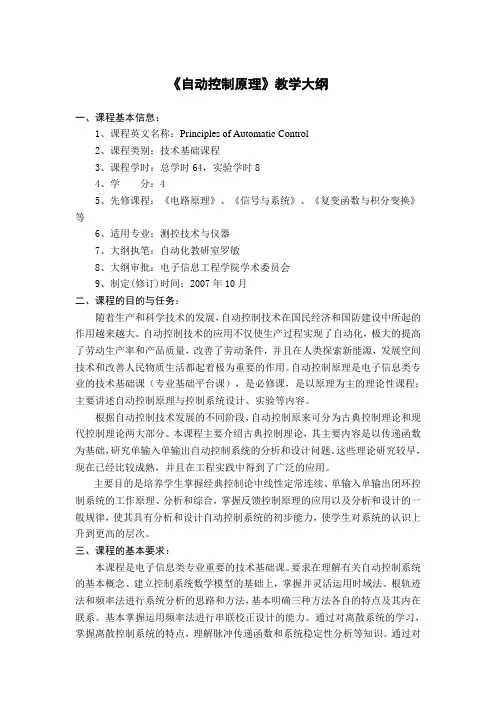
《自动控制原理》教学大纲一、课程基本信息:1、课程英文名称:Principles of Automatic Control2、课程类别:技术基础课程3、课程学时:总学时64,实验学时84、学分:45、先修课程:《电路原理》、《信号与系统》、《复变函数与积分变换》等6、适用专业:测控技术与仪器7、大纲执笔:自动化教研室罗敏8、大纲审批:电子信息工程学院学术委员会9、制定(修订)时间:2007年10月二、课程的目的与任务:随着生产和科学技术的发展,自动控制技术在国民经济和国防建设中所起的作用越来越大。
自动控制技术的应用不仅使生产过程实现了自动化,极大的提高了劳动生产率和产品质量,改善了劳动条件,并且在人类探索新能源,发展空间技术和改善人民物质生活都起着极为重要的作用。
自动控制原理是电子信息类专业的技术基础课(专业基础平台课),是必修课,是以原理为主的理论性课程;主要讲述自动控制原理与控制系统设计、实验等内容。
根据自动控制技术发展的不同阶段,自动控制原来可分为古典控制理论和现代控制理论两大部分。
本课程主要介绍古典控制理论,其主要内容是以传递函数为基础,研究单输入单输出自动控制系统的分析和设计问题。
这些理论研究较早,现在已经比较成熟,并且在工程实践中得到了广泛的应用。
主要目的是培养学生掌握经典控制论中线性定常连续、单输入单输出闭环控制系统的工作原理、分析和综合,掌握反馈控制原理的应用以及分析和设计的一般规律,使其具有分析和设计自动控制系统的初步能力,使学生对系统的认识上升到更高的层次。
三、课程的基本要求:本课程是电子信息类专业重要的技术基础课。
要求在理解有关自动控制系统的基本概念、建立控制系统数学模型的基础上,掌握并灵活运用时域法、根轨迹法和频率法进行系统分析的思路和方法,基本明确三种方法各自的特点及其内在联系。
基本掌握运用频率法进行串联校正设计的能力。
通过对离散系统的学习,掌握离散控制系统的特点,理解脉冲传递函数和系统稳定性分析等知识。

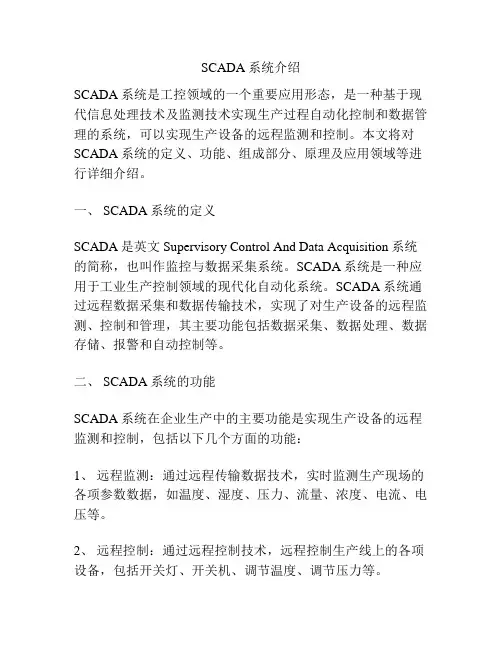
SCADA系统介绍SCADA系统是工控领域的一个重要应用形态,是一种基于现代信息处理技术及监测技术实现生产过程自动化控制和数据管理的系统,可以实现生产设备的远程监测和控制。
本文将对SCADA系统的定义、功能、组成部分、原理及应用领域等进行详细介绍。
一、 SCADA系统的定义SCADA是英文Supervisory Control And Data Acquisition系统的简称,也叫作监控与数据采集系统。
SCADA系统是一种应用于工业生产控制领域的现代化自动化系统。
SCADA系统通过远程数据采集和数据传输技术,实现了对生产设备的远程监测、控制和管理,其主要功能包括数据采集、数据处理、数据存储、报警和自动控制等。
二、 SCADA系统的功能SCADA系统在企业生产中的主要功能是实现生产设备的远程监测和控制,包括以下几个方面的功能:1、远程监测:通过远程传输数据技术,实时监测生产现场的各项参数数据,如温度、湿度、压力、流量、浓度、电流、电压等。
2、远程控制:通过远程控制技术,远程控制生产线上的各项设备,包括开关灯、开关机、调节温度、调节压力等。
3、数据记录:自动记录生产现场的各项参数数据,并进行存储,便于历史数据的查询和统计分析。
4、报警提示:根据预设的参数阈值,当生产现场某些参数出现异常时,及时发出报警提示,以保障生产设备的安全运行。
三、 SCADA系统的组成部分SCADA系统分为两个主要部分:前端和后端。
前端负责数据采集、数据处理、监视等工作,后端负责数据存储、统计分析、报警处理等工作。
下面将对SCADA系统的组成部分进行详细介绍。
1、前端前端包括数据采集设备、人机界面和通信模块等几个部分。
(1)数据采集设备数据采集设备通常由传感器、信号处理器、数据采集卡、数据采集仪器等组成。
传感器主要负责测量生产现场各项参数,信号处理器则负责对传感器采样的模拟信号进行处理,并将处理后的信号转化为数字量信号,数字量信号经过数据采集卡转化为计算机能够识别的信号,最后数据采集仪器将数据发送到计算机,供后续处理使用。
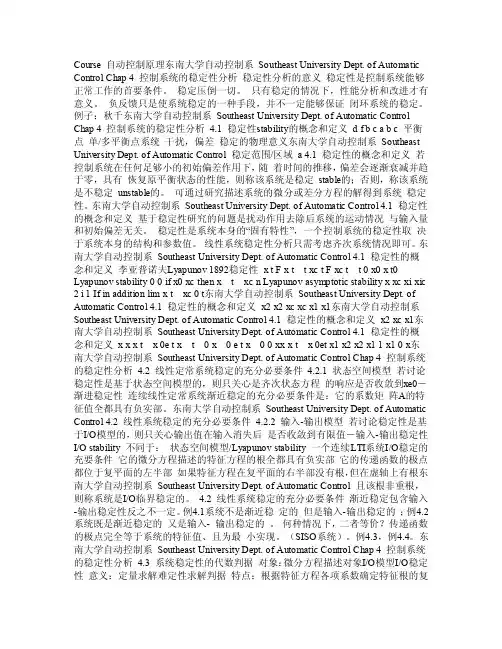
Course 自动控制原理东南大学自动控制系Southeast University Dept. of Automatic Control Chap 4 控制系统的稳定性分析稳定性分析的意义稳定性是控制系统能够正常工作的首要条件。
稳定压倒一切。
只有稳定的情况下,性能分析和改进才有意义。
负反馈只是使系统稳定的一种手段,并不一定能够保证闭环系统的稳定。
例子:秋千东南大学自动控制系Southeast University Dept. of Automatic Control Chap 4 控制系统的稳定性分析4.1 稳定性stability的概念和定义d f b c a b c 平衡点单/多平衡点系统干扰,偏差稳定的物理意义东南大学自动控制系Southeast University Dept. of Automatic Control 稳定范围/区域a 4.1 稳定性的概念和定义若控制系统在任何足够小的初始偏差作用下,随着时间的推移,偏差会逐渐衰减并趋于零,具有恢复原平衡状态的性能,则称该系统是稳定stable的;否则,称该系统是不稳定unstable的。
可通过研究描述系统的微分或差分方程的解得到系统稳定性。
东南大学自动控制系Southeast University Dept. of Automatic Control 4.1 稳定性的概念和定义基于稳定性研究的问题是扰动作用去除后系统的运动情况与输入量和初始偏差无关。
稳定性是系统本身的“固有特性”,一个控制系统的稳定性取决于系统本身的结构和参数值。
线性系统稳定性分析只需考虑齐次系统情况即可。
东南大学自动控制系Southeast University Dept. of Automatic Control 4.1 稳定性的概念和定义李亚普诺夫Lyapunov 1892稳定性x t F x t t xc t F xc t t 0 x0 x t0 Lyapunov stability 0 0 if x0 xc then x t xc n Lyapunov asymptotic stability x xc xi xic 2 i 1 If in addition lim x t xc 0 t东南大学自动控制系Southeast University Dept. of Automatic Control 4.1 稳定性的概念和定义x2 x2 xc xc x1 x1东南大学自动控制系Southeast University Dept. of Automatic Control 4.1 稳定性的概念和定义x2 xc x1东南大学自动控制系Southeast University Dept. of Automatic Control 4.1 稳定性的概念和定义x x x t x 0e t x t 0 x 0 e t x 0 0 xx x t x 0et x1 x2 x2 x1 1 x1 0 x东南大学自动控制系Southeast University Dept. of Automatic Control Chap 4 控制系统的稳定性分析4.2 线性定常系统稳定的充分必要条件4.2.1 状态空间模型若讨论稳定性是基于状态空间模型的,则只关心是齐次状态方程的响应是否收敛到xe0-渐进稳定性连续线性定常系统渐近稳定的充分必要条件是:它的系数矩阵A的特征值全都具有负实部。
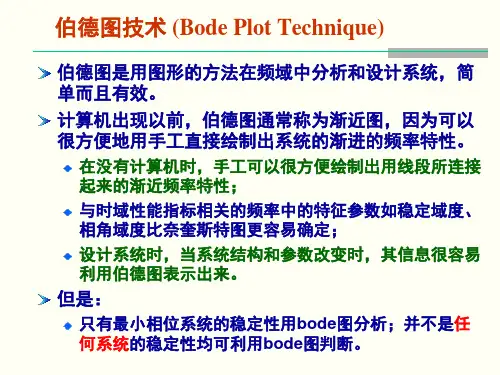
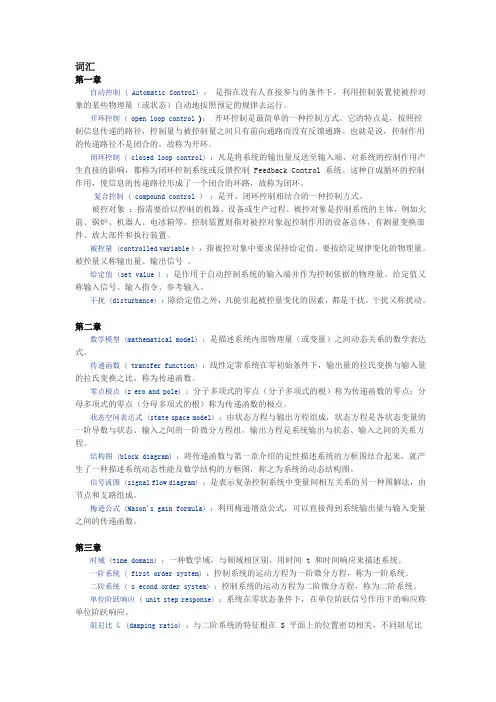
词汇第一章自动控制 ( Automatic Control) :是指在没有人直接参与的条件下,利用控制装置使被控对象的某些物理量(或状态)自动地按照预定的规律去运行。
开环控制 ( open loop control ):开环控制是最简单的一种控制方式。
它的特点是,按照控制信息传递的路径,控制量与被控制量之间只有前向通路而没有反馈通路。
也就是说,控制作用的传递路径不是闭合的,故称为开环。
闭环控制 ( closed loop control) :凡是将系统的输出量反送至输入端,对系统的控制作用产生直接的影响,都称为闭环控制系统或反馈控制 Feedback Control 系统。
这种自成循环的控制作用,使信息的传递路径形成了一个闭合的环路,故称为闭环。
复合控制 ( compound control ):是开、闭环控制相结合的一种控制方式。
被控对象:指需要给以控制的机器、设备或生产过程。
被控对象是控制系统的主体,例如火箭、锅炉、机器人、电冰箱等。
控制装置则指对被控对象起控制作用的设备总体,有测量变换部件、放大部件和执行装置。
被控量 (controlled variable ) :指被控对象中要求保持给定值、要按给定规律变化的物理量。
被控量又称输出量、输出信号。
给定值 (set value ) :是作用于自动控制系统的输入端并作为控制依据的物理量。
给定值又称输入信号、输入指令、参考输入。
干扰 (disturbance) :除给定值之外,凡能引起被控量变化的因素,都是干扰。
干扰又称扰动。
第二章数学模型 (mathematical model) :是描述系统内部物理量(或变量)之间动态关系的数学表达式。
传递函数 ( transfer function) :线性定常系统在零初始条件下,输出量的拉氏变换与输入量的拉氏变换之比,称为传递函数。
零点极点 (z ero and pole) :分子多项式的零点(分子多项式的根)称为传递函数的零点;分母多项式的零点(分母多项式的根)称为传递函数的极点。
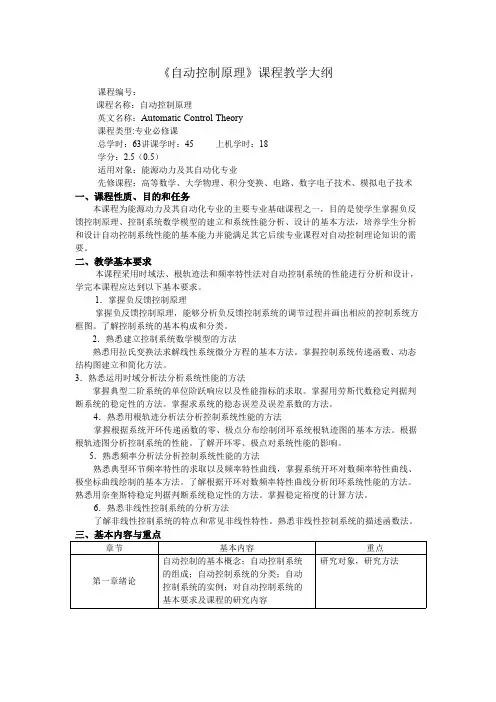
《自动控制原理》课程教学大纲课程编号:课程名称:自动控制原理英文名称:Automatic Control Theory课程类型:专业必修课总学时:63讲课学时:45 上机学时:18学分:2.5(0.5)适用对象:能源动力及其自动化专业先修课程:高等数学、大学物理、积分变换、电路、数字电子技术、模拟电子技术一、课程性质、目的和任务本课程为能源动力及其自动化专业的主要专业基础课程之一,目的是使学生掌握负反馈控制原理、控制系统数学模型的建立和系统性能分析、设计的基本方法,培养学生分析和设计自动控制系统性能的基本能力并能满足其它后续专业课程对自动控制理论知识的需要。
二、教学基本要求本课程采用时域法、根轨迹法和频率特性法对自动控制系统的性能进行分析和设计,学完本课程应达到以下基本要求。
1.掌握负反馈控制原理掌握负反馈控制原理,能够分析负反馈控制系统的调节过程并画出相应的控制系统方框图。
了解控制系统的基本构成和分类。
2.熟悉建立控制系统数学模型的方法熟悉用拉氏变换法求解线性系统微分方程的基本方法。
掌握控制系统传递函数、动态结构图建立和简化方法。
3.熟悉运用时域分析法分析系统性能的方法掌握典型二阶系统的单位阶跃响应以及性能指标的求取。
掌握用劳斯代数稳定判据判断系统的稳定性的方法。
掌握求系统的稳态误差及误差系数的方法。
4.熟悉用根轨迹分析法分析控制系统性能的方法掌握根据系统开环传递函数的零、极点分布绘制闭环系统根轨迹图的基本方法。
根据根轨迹图分析控制系统的性能。
了解开环零、极点对系统性能的影响。
5.熟悉频率分析法分析控制系统性能的方法熟悉典型环节频率特性的求取以及频率特性曲线,掌握系统开环对数频率特性曲线、极坐标曲线绘制的基本方法。
了解根据开环对数频率特性曲线分析闭环系统性能的方法。
熟悉用奈奎斯特稳定判据判断系统稳定性的方法。
掌握稳定裕度的计算方法。
6.熟悉非线性控制系统的分析方法了解非线性控制系统的特点和常见非线性特性。
《自动控制理论A》课程教学大纲课程名称:自动控制理论A英文名称:Automatic Control Theory A课程代码:190807439学分/学时:3.5学分60学时(其中理论52学时、实验8学时)开课学期:第4学期适用专业:自动化专业先修课程:大学物理、电路分析基础、模拟电子技术等后续课程:自动化专业综合设计、自动化专业生产实习、自动化专业毕业设计等课程负责人:开课单位:电气与电子信息学院一、课程性质和课程目标1.课程性质自动控制理论是自动化、轨道交通信号与控制、电气工程及其自动化等专业的一门重要的专业基础必修课。
通过本课程学习,使学生掌握自动控制理论的基本知识,具备应用控制的思想分析问题的意识,能够利用自动控制理论的相关知识分析、设计实际控制系统的能力,为后续控制类专业课程打下重要的基础。
2.课程目标课程目标1:掌握系统数学模型的建立方法。
课程目标2:掌握模拟控制系统分析的时域法、根轨迹法、频域法,离散控制系统的分析方法,掌握每种方法下对系统稳定性、准确性、快速性指标的计算。
课程目标3:了解PID控制规律,掌握控制系统校正的串联超前、滞后、滞后-超前等手段,改善控制系统性能指标。
课程目标4:通过使用MA TLAB/SIMULINK仿真平台结合控制理论演示控制系统搭建与分析,掌握仿真平台分析控制系统的手段,拓展学生对控制理论的自我研究与探索。
课程目标5:能根据提供的实验设备,搭建实验对象,在实验中验证控制系统分析的不同方法,通过调节调节器,改善系统性能指标并能对实验数据进行分析和解释,得出有效结论。
二、课程目标与毕业要求指标点的对应关系三、教学内容、教学方式(环节)与课程目标的关系四、教学方法及手段本课程以课堂讲授为主,结合实验和作业共同实施,辅以自学。
1. 课堂讲授(1) 采用多媒体教学与板书教学相结合,以老师讲授为主,并辅以课堂讨论、多媒体演示等教学手段,提高课堂教学信息量,增强学生的学习积极性和主动性。
《自动控制原理》课程标准第一部分课程概述一、课程名称中文名称:《自动控制原理》英文名称:《Automatic control theory》二、学时与适用对象课程总计72学时,其中理论课62学时,实验10学时。
本标准适用于三年制专科机械工程专业。
三、课程地位、性质《自动控制原理》是研究自动控制共同规律的技术科学,是工科高等院校电类、控制类、机械类等专业的一门主干技术基础课程。
该课程的开设重在使学生掌握与自动控制原理相关的专业知识和综合应用能力,培养解决自动控制系统调试与维护方面实际问题的能力。
掌握和了解自动控制的基本理论和方法,对从事机械工程专业的工程技术人员是很有必要的。
四、课程基本理念本课程的教学应把握以下几点基本原则:一是增加对前沿和最具特色机械装备研发、使用、推广等背景知识的介绍,激发学员对该课程的探索兴趣;二是突出从理工类专业的角度理解设备运行原理和设计思路的方法,向学员强调学好这门课必须具备数学、电子学、计算机软硬件方面坚实的知识基础,重在自动控制系统的分析与改进,体现有别于理工院校自动控制课程的强调理论探索、侧重系统设计及实现等的教学模式;三是鼓励学员查询相关资料、书籍,不要满足于仅仅了解系统原理的简单程度,强化学员的自学能力,培养获取并运用信息的能力,为今后从事机械装备的创新型革新及研制打好基础;四是注重与学员的交流、并积极引导学员之间的相互交流,培养良好协作的团队精神。
五、课程设计思路在本课程开设之前,学员已经具备了多门课程的先导知识。
在教学过程中,鼓励学员学习和使用MATLAB软件,对于课堂作业,通过MATLAB进行验证。
讲授中应力争多介绍自动化领域前沿成果,拓展学员的知识面,启发解决问题的思路。
在总结教学经验和研究成果的基础上,对课程目标分别从知识与技能、过程与方法、情感态度与价值观等方面进行具体明确的阐述。
1.依据课程特点,设计教学思路自动控制原理是研究在没有人直接参与的情况下,利用外加的设备或装置(称控制装置或控制器),使机器,设备或生产过程(统称被控对象)的某个工作状态或参数(即被控制量)自动地按照预定的规律运行的原理及技术,数学基础要求较高,理论性很强。
《自动控制理论II》中英文课程简介英文名称:Automatic Control Principle 课程编号:适用专业:安全工程测控技术与仪器电气工程及其自动化学时:72学分:4实验学时:8课内上机学时:0一、预修课程高等数学Ⅰ、复变函数与积分变换Ⅰ、线性代数Ⅰ、电路分析基础二、中文内容提要《自动控制理论II》主要介绍了自动控制理论的基本概念、分析方法和设计方法。
通过本课程的学习,使学生能够建立起控制系统的数学模型,利用经典控制理论和现代控制理论的分析方法进行系统的性能分析,并能够根据系统性能指标的要求进行系统的设计。
三、英文内容提要Automatic Control Principle mainly introduces: basic conceptions of automatic control principle, analytical methods, and design methods. The purpose is that students can found a mathematic model and systematically analyze capability of system and design system according to demand of capability index by studying this course.四、教材:《自动控制原理》.胡寿松.科学出版社,2004年五、教材类别:校外编制订者(签字):校对者(签字):审定者(签章):批准者(签章):《自动控制理论Ⅱ》课程教学大纲英文名称:Automatic Control Principle课程编号:适用专业:安全工程测控技术与仪器电气工程及其自动化学时:72 学分:4课程类别:学科大类基础课课程性质:必修课一、课程的性质和目的本课程是一门必修课。
通过本课程的学习,使学生建立经典控制理论部分的基本概念,学习现代控制理论的基本内容,掌握反馈控制原理的应用以及系统分析和设计的一般规律,同时,通过本课程的学习,使学生建立线性离散系统控制理论的基本概念,掌握线性离散系统分析和设计的一般规律。
自动控制原理专业词汇中英文对照自动控制原理专业词汇中英文对照中文英文自动控制automatic control;cybernation 自动控制系统automatic control system自动控制理论 automatic control theory经典控制理论 classical control theory现代控制理论 modern control theory智能控制理论intelligent control theory 开环控制open-loop control闭环控制 closed-loop control输入量 input输出量 output给定环节 given unit/element比较环节 comparing unit/element放大环节 amplifying unit/element执行环节 actuating unit/element控制环节 controlling unit/element被控对象 (controlled) plant反馈环节 feedback unit/element控制器 controller扰动/干扰 perturbance/disturbance前向通道 forward channel反馈通道feedback channel 恒值控制系统constant control system随动控制系统servo/drive control system 程序控制系统programmed control system 连续控制系统continuous control system离散控制系统 discrete control system线性控制系统 linear control system非线性控制系统 nonlinear control system定常/时不变控制系统time-invariant control system 时变控制系统 time-variant control system 稳定性 stability快速性 rapidity准确性 accuracy数学模型 mathematical model微分方程 differential equation非线性特性 nonlinear characteristic线性化处理 linearization processing泰勒级数 Taylor series传递函数 transfer function比例环节 proportional element积分环节 integrating element一阶惯性环节 first order inertial element二阶惯性环节 second order inertial element二阶震荡环节second order oscillation element 微分环节differentiation element一阶微分环节 first order differentiation element二阶微分环节 second order differentiation element 延迟环节delay element动态结构图 dynamic structure block串联环节 serial unit并联环节 parallel unit信号流图 signal flow graph梅逊增益公式Mason’s gain formula时域分析法 time domain analysis method性能指标 performance index阶跃函数 step function斜坡函数 ramp function抛物线函数 parabolic function /acceleration function 冲击函数impulse function正弦函数 sinusoidal function动态/暂态响应 transient response静态/稳态响应 steady-state response 延迟时间 delay time上升时间 rise time峰值时间 peak time调节时间 settling time最大超调量 maximum overshoot稳态误差 steady-state error无阻尼 undamping欠阻尼 underdamping过阻尼 overdamping特征根 eigen root极点 pole零点 zero实轴 real axis虚轴 imaginary axis 稳态/静态分量 steady-state component 瞬态/暂态/动态分量transient component 运动模态motion mode衰减 attenuation系数 coefficient初相角 initial phase angle响应曲线 response curve主导极点 dominant pole 劳斯稳定判据 Routh stability criterion S平面 S plane胡尔维茨稳定判据Hurwitz stability criterion 测量误差measurement error扰动误差 agitation error结构性误差 structural error偏差 deviation根轨迹 root locus 常规根轨迹 routine root locus根轨迹方程 root locus equation 幅值 magnitude幅角 argument对称性 symmetry分离点 separation/break away point会合点 meeting/break-in point渐近线 asymptote出射角 emergence angle/angle of departure入射角incidence angle/angle of arrival 广义根轨迹generalized root locus零度根轨迹zero degree root locus 偶极子dipole/zero-pole pair 频域分析法frequency-domain analysis method 频率特性frequency characteristic极坐标系 polar coordinate system直角坐标系 rectangular coordinate system幅频特性 magnitude-frequency characteristic相频特性phase-frequency characteristic 幅相频率特性magnitude-phase frequency characteristic 最小相位系统minimum phase system非最小相位系统 nonminimum phase system奈奎斯特稳定判据Nyquist stability criterion 伯德定理Bode theorem稳定裕度 stability margin幅值裕度 magnitude margin 相位/相角裕度 phase margin对数幅频特性 log magnitude-frequency characteristic 无阻尼自然震荡角频率 undamped oscillation angular frequency 阻尼震荡角频率damped oscillation angular frequency 阻尼角damping angle带宽频率bandwidth frequency 穿越/截止频率crossover/cutoff frequency 谐振峰值 resonance peak系统校正 system compensation超前校正 lead compensation滞后校正 lag compensation自激震荡 self-excited oscillation死区特性 dead zone characteristic饱和特性 saturation characteristic间隙特性 backlash characteristic描述函数法 describing function method相平面法 phase plane method 采样控制系统 sampling control system数字控制系统 digital control system频谱 frequency spectrum 采样定理 sampling theorem信号重现 signal recurrence拉氏变换 Laplace transformZ变换 Z transform终值定理 final-value theorem差分方程 difference equation迭代法 iterative method 脉冲传递函数 pulse transfer function 零阶保持器 zero-order holder映射 mapping方框图 block diagram伯德图 Bode diagram特征方程 characteristic equation可控性 controllability临界阻尼 critical damping阻尼常数 damping constant阻尼比 damping ratio初始状态 initial state初值定理 initial-value theorem反Z变换 inverse Z-transformation负反馈 negative feedback正反馈 positive feedback 尼科尔斯图 Nichols chart部分分式展开partial fraction expansion 幅角原理argument principle相对稳定性 relative stability共振频率 resonant frequency劳斯表 Routh tabulation/array奇点 singularity渐进稳定性 asymptotic stability控制精度 control accuracy临界稳定性 critical stability耦合 coupling解耦 decoupling比例积分微分调节器proportional integral derivative regulator(PID) 串联校正 series/cascade compensation 单输入单输出 single input single output(SISO)多输入多输出 multi input multi output(MIMO)低通滤波器 low pass filter非线性系统 nonlinear system复合控制 compound control衰减振荡 damped oscillation主反馈 monitoring feedback 转折(交接)频率 break frequency 稳定焦点/节点 stable focus/node。
Classification of control systems there are three ways: by automatic classification methods in order to participate in the control mode classification, to adjust the law category.One way to control category 1, the open-loop control system if the computer output of open loop control system to exercise control of the production process, but the control results --- the state of the production process does not affect the computer control systems, computer \ controller \ production and other sectors does not constitute a closed loop, is called open-loop control system computer. the production process of the state is no feedback to the computer, but by the operator to monitor the status of the production process, decision control program, and tell the computer to control the role of exercising control. 2, closed loop control system computer to the production of an object or process control, the state can directly influence the production process computer control system, called the closed-loop control system computer. Control of the computer monitor in the operator, the automatic acceptance of the production process state test results, calculate and determine the control scheme, the direct command and control units (devices) of action, the role of exercising control of the production process. In such systems, aircraft control components under control of control information sent to control device operation, the other running equipment condition as the output, measured by the detection part, the feedback as input to the control computer; to make control Computer \ Control Components \ production \ test components form a closed loop. We will call this form of control computer control closed-loop control. Closed loop control system computer, using a mathematical model to set the value of the production process and test results of the best value of the deviation between the feedback and control the production process to run at their best. 3, line control system as long as the computer controlled production of the controlled object or process, to exercise direct control, without human intervention are called the control computer on-line control, or on-line control system. 4, offline control system control computer does not directly participate in the control object or the controlled production process. It only managed to complete the process of the controlled object or the status of testing, and testing of data processing; and then develop control programs, the output control instruction, operator reference control instructions manually controlled operation to control parts of the object or subject control process control. This control form is called off-line computer control system. 5, real-time control system control computer real-time control system iscontrolled by the control of the object or process, or request when the request processing control, the control function in a timely manner to address and control systems, commonly used in the production process is interrupted for the occasion. Such as steel, each one refining furnace steel is a process; and if the process rolling, rolling out each piece of steel considered a process, each process is repeated. Only enter the process only requires a computer control. Once control of the computer, it requires a computer from the production process information in the required time to respond to or control. Such systems often use sophisticated interrupt system and interrupt handling procedures to achieve. In summary, an online system is not necessarily a real-time system. But a real-time system must be an online system.Second, in order to participate in the control mode to Category 1, direct digital control system by the control computer to replace conventional analog instruments and direct regulation to control the production process, as the computer as digital signals, so named after the DDC control. Actually controlled the production process control components, control signals received by the process controller input / output channels of D / (D / A) converter output of the digital control computer volume to be converted into analog; analog input control machine to go through the process of input / output channels of analog / digital (A / D) converter into a digital number into the computer. DDC control systems often use a small computer or microprocessor, the time-sharing system to achieve multiple points of control. Is in fact a discrete sampling with the controller, to achieve discrete multi-point control. DDC computer control system that has become the main control computer control system forms. DDC control of the advantage of flexibility, large, focused on high reliability and low cost. Can use several forms of digital computing circuits, or even dozens of loop production process, integral to proportional --- --- differential (PID) control to maintain the industrial state of the controlled object at a given value, the deviation small and stable. And as long as the change of control algorithms and applications can achieve more complex control. Such as feedforward control and the best control. Under normal circumstances, DDC-level control often more complex as the implementation of advanced control level. 2, supervisory computer control system supervisory computer control system for a particular production process, according to the production process of various states, according to the production process of the mathematical model to calculate the best production equipment should be running a given value, and the best value automatically or manually on the DDCExecutive-level computer or analog meter to align the regulation or control of the target set. By a DDC or adjust the instrument at various points on the production process (running equipment) to exercise control. SCC system is that it can guarantee the production process is always controlled the situation in the best condition to run, so get the most benefit. SCC results directly affect the merits of the first of its mathematical model, this should always improve the operation process model, and modify the control algorithm, and application control procedures. 3, multi-level control systems in modern manufacturing enterprises in the production process not only the need to address the problem of online control, and Huan Zhi Li called for a solution of production problems, the daily product line, the number of arrangements for planning and scheduling, and Rose plans develop a long term planning, notice Xiaoshou prospects, there was multi-level control system. DDC class is mainly used for direct control of the production process, for PID, or feedforward control; SCC level is mainly used for optimal control or adaptive control or learning control calculation, and command and control the same DDC class report back to the MIS class. DDC level usually microcomputers, SCC-level general use of small computers or high-end microcomputers. MIS Workshop main function of governance is based on plant-level production of varieties issued, the number of orders and collect up the production process of the state of information, at any time reasonable schedule to achieve optimal control, command and SCC-level supervisory control. Factory management level MIS main function is to accept the company and factory production tasks assigned by the actual situation of optimized computing, Zhi Ding factory production plans and short-term (ten days or weeks or days) arrangements, and then issued to the plant-level production tasks. Corporate governance level MIS main function is to guess the market demand computing to develop strategic long-term development planning, and contract orders, raw material supply situation and the production conditions, comparison of the optimal production program selection and calculation, work out the entire company business a long time (months or ten days) of the production plan, sales plan, assigned to the task of the factory management level. MIS-level main function is to achieve real-time information processing, decision-makers at all levels to provide useful information, make on the production planning \ scheduling and management programs to plan the coordination and management control in the optimal state. This one can control the size and scope of enterprise size divided into several levels. Each level has to be addressed accordingto the size of the amount of information to determine the type of computer used. MIS generally use small computer shop class or high-grade micro-computer, the factory management level of the MIS with a medium-sized computer, and corporate governance level MIS is to use large-scale computer, or use super computer. 4, distributed control or distributed control system distributed control or distributed control, the control system is divided into a number of independent local control subsystems to complete the controlled production process control task. Since the emergence of micro-computers and rapid development of distributed control to provide for the realization of the material and technical basis, in recent years, decentralized control can be different almost normal development, and has become an important trend in the development of computer control. Since the 70's, appeared focused on distributed control system, called DCS. It is a decentralized local control of the new computer control system.Three, classified according to the law regulating 1, program control if the computer control system the division of a predetermined time function control, such control is called program control. Such as the furnace temperature-time curves Anzhao some control on the process control. Here the procedure is time-varying changes have to determine the corresponding value, rather than the computer running. 2, sequence control in the process control based on the generated sequence control, computer, over time, as can be determined according to the corresponding control value and previous results at the moment both to exercise on the production process control system, called the order of the computer control . 3, proportional - integral - differential analog PID control regulation of conventional PID control instrument can be completed. Micro-computer can also be achieved with PID control. 4, feedforward control is usually the feedback control system, have certain effects on the interference in order to generate feedback over the role of inhibitory control of interference, and thus delay the control of undesirable consequences. In order to overcome the negative lag control, with the computer accepts the interference signal after the, did not produce effects in the Huan insert a feedforward control Zuoyong, it Ganghao interference point in the interference of the control to completely offset the effect on the variable, it was Ming Wei Yin Er disturbance compensation control. 5, optimal control (optimal control) system control computer, such as to have controlled object is best known as the best run of the control system control system. Such as computer control system is limited in the existing conditions, select appropriate control law(mathematical model), the controlled object indicators in optimal running condition. Such as the largest output, consumption of the largest, highest quality standards, such as the least scrap rate. Best is determined by a set of mathematical models, sometimes several in a limited range of the best indicators of the pursuit of individual, sometimes the best indicators of comprehensive requirements. 6, the adaptive control system, optimal control, when the working conditions or qualifications change, we can not get the best control effects. If the situation changes in working conditions, the control system can still be controlled in the best state of the object's control, such control system called the adaptive system. This requires mathematical model reflects the change in the conditions, how to achieve the best state. Control computer to detect changes in terms of the information given by the laws of mathematical models to calculate, to change the control variables, the controlled objects still in the best condition. 7, self-learning control system if the computer can keep the results under the controlled object gain experience running their own change and improve the control law so that more and better control effect, this control system is called self-learning control system. Above mentioned optimal control, adaptive control and self-learning control are related to multi-parameter, multi-variable complex control systems, are all problems of modern control theory. Determine the stability of the system, many factors affect the control of complex mathematical models, have to be a production control, production technology, automation, instrumentation, programming, computer hardware, each with various personnel to be realized. Controlled object by the length of reaction time required to control the number of points and mathematical models to determine the complexity of the computer use scale. Generally speaking, a strong need to functionality (speed and computing power) of the computer can be achieved. The Zhuzhong control, can be a single type also is not single, you can combine several forms to achieve control of the production process. This should address the actual situation of the controlled object, the system analysis, system design determined at the time.Keywords :open the control,closed loop control。